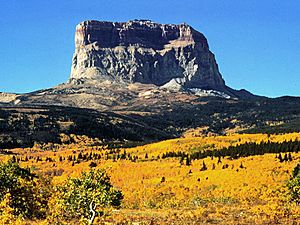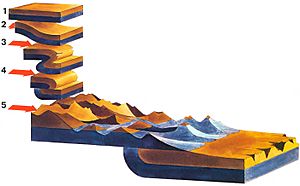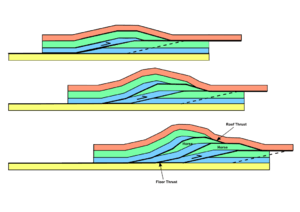Lewis Overthrust facts for kids
The Lewis Overthrust is a huge fault in the Rocky Mountains. Imagine a giant crack in the Earth where a massive slab of rock slid over another! This amazing geological feature is found in Glacier National Park in Montana, USA, and Waterton Lakes National Park in Alberta, Canada.
It formed about 170 million years ago when Earth's tectonic plates crashed into each other. This collision pushed a thick wedge of rock, about 50 miles (80 km) wide, eastward. This ancient rock then ended up on top of much younger rock, which was 400 to 500 million years younger!
Contents
Where is the Lewis Overthrust?
The Lewis Overthrust is a major part of the Rocky Mountains in Canada and the United States. It stretches for over 450 kilometers (about 280 miles) from Mount Kidd in Alberta, Canada, all the way to Steamboat Mountain in Montana, USA.
Studying the Lewis Overthrust helps scientists understand how other big mountain ranges around the world, like the Andes and the Himalaya Mountains, were formed. It's like a natural laboratory for geology!
How the Rocky Mountains Formed
Earth's Plates Collide
The formation of the Rocky Mountains began about 170 million years ago. At that time, the supercontinent Pangaea was breaking apart. The North American plate started moving towards areas where it would crash into other plates.
Many pieces of land, called "terranes," were added to the western edge of North America. These terranes were like islands or small continents that drifted and then collided with the main North American landmass. When they crashed, the upper layers of rock broke off and piled up on top of each other. This created a system of huge thrust faults, where rocks were pushed over other rocks.
The Rise of the Rockies
The Rocky Mountains began to rise because of these powerful collisions on the western edge of North America. This mountain-building process happened between 80 and 55 million years ago, during an event called the Laramide orogeny. It was caused by the Kula and Farallon plates sliding under the North American continent.
Imagine a giant rug being pushed from one side – it wrinkles and folds up. That's similar to what happened with the Earth's crust! Layers of sedimentary rocks, which had been laid down over millions of years, were pushed, folded, and broken. This created the "fold and thrust belt" that makes up the Rocky Mountains.
The Lewis Overthrust is the largest of these thrust faults. It shows how much the Earth's crust was squeezed and shortened horizontally – up to 200 kilometers (about 124 miles) near the Canada-US border!
The Lewis Thrust System
The Lewis Thrust is a special type of thrust fault where very old rocks (from the Precambrian era) were pushed over much younger rocks (from the Cretaceous period).
As the Lewis sheet of rock moved, it was squeezed and folded. Sometimes, the rock layers even turned upside down before a new fault formed. This process lifted huge amounts of rock, creating the tall peaks we see in the Canadian Rockies today.
Over time, other faults, like the Flathead fault and the Rocky Mountain trench fault system, cut across the Lewis Thrust. These newer faults formed much later, between 55 and 23 million years ago.
Scientists have studied the thickness of the Lewis thrust sheet. They believe it was about 12 to 13.5 kilometers (7.5 to 8.4 miles) thick when it started moving.
Duplex Structures and Chief Mountain
When rocks are pushed along thrust faults, they often form interesting structures. One common type is called a "duplex." Imagine stacking several thin books on top of each other, but each book is also slightly pushed forward – that's a bit like a duplex structure in rocks.
Scientists have found many duplex structures along the Lewis Thrust. For example, near Marias Pass in Montana, the Lewis Thrust follows layers of rock. In some places, younger rocks are exposed beneath the Lewis Thrust, forming "windows" where we can see what's underneath.

A great example of the Lewis Overthrust's power is Chief Mountain in Glacier National Park. This mountain is an isolated piece of the upper rock plate that was pushed forward by the Lewis Thrust. Over millions of years, Erosion by wind, water, and ice shaped Chief Mountain into its distinctive towering form. It stands tall over the surrounding plains, a clear sign of the massive geological forces that created it.
When Did the Lewis Thrust Move?
Scientists use special methods to figure out when the Lewis Thrust was active. They study tiny minerals like zircons and apatite found in the rocks. These minerals contain radioactive elements that act like tiny clocks. By measuring these elements, scientists can determine the age of the rocks and when they were heated or moved.
The oldest movement along the Lewis Thrust is believed to have started around 75 million years ago. This is supported by evidence where the fault cuts through volcanic rocks that are 76 million years old. This means the fault must be younger than those rocks.
The youngest movement along the fault ended around 59 million years ago. This is based on the age of other faults that cut across the Lewis Thrust and the rocks found within them.
So, the main movement of the Lewis Overthrust happened over a period of about 15 million years, between 75 and 59 million years ago.
How Far Did the Rocks Move?
Scientists use special techniques, like seismic analysis (which uses sound waves to "see" through the Earth), to understand how much the Lewis Thrust sheet moved.
One study used seismic data along the border between Canada and the US. It showed that the Lewis Thrust sheet moved a total of about 115 kilometers (about 71 miles)! About 75 kilometers (47 miles) was direct movement along the main fault. The other 40 kilometers (25 miles) was due to the formation of those "duplex" structures we talked about earlier.
There's still some debate about whether the movement was continuous or if it happened in sudden, quick bursts, like an earthquake. However, evidence suggests that the movement likely happened in pulses, with periods of activity followed by quieter times.
Images for kids
See also
 In Spanish: Cabalgamiento Lewis para niños
In Spanish: Cabalgamiento Lewis para niños





